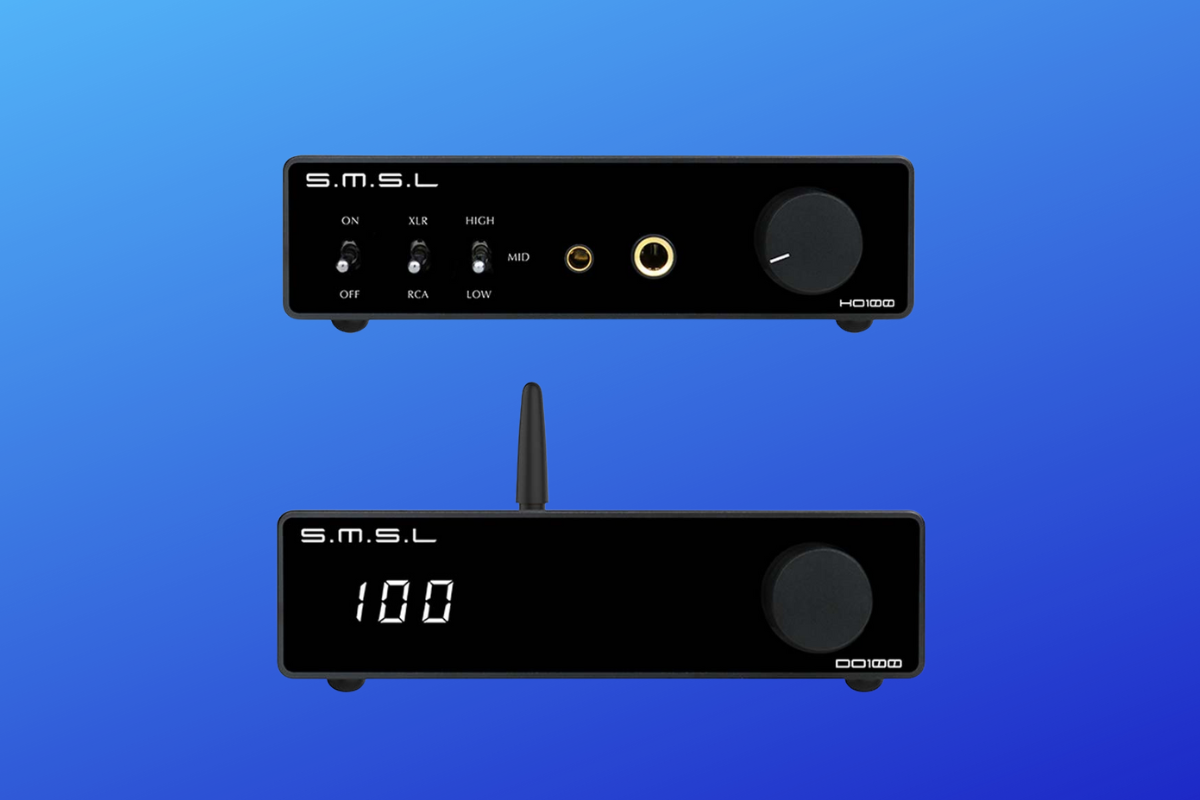TD; LR
The SMSL DO100 + HO100 stack is an excellent entryway into DAC/Amp separates. They’re well built and provide exceptional detail, depth, and soundstage.
Intro:
While I like the simplicity, affordability, and utility of all-in-one desktop DAC/Amp combos, matching DAC and Headphone Amp separates or “stacks” have become all the rage right now, as they offer similar benefits to hi-fi separates.
As with 2-channel power amps and stereo preamps, separate DACs and headphone amps have individual chassis and power supplies, which allows them to have more robust circuitry than an all-in-one DAC/Amp combo.
The more robust build of separates provides greater performance in most cases, and nowadays, they don’t cost much more than the combination units. The combos are nice if you don’t want to fuss with a bunch of cables or don’t have much room, but otherwise, a nice “stack” could be the way to go.
With this in mind, today we’re looking at the new DAC/Amp stack from SMSL, comprised of the $149 HO100 Headphone Amp and the matching $239 DO100 Hi-Res Audio DAC. Both of these devices look really good, both on paper and the desktop. In addition, they have a ton of features for their combined price of $388.
So they look good, and they’re cheap, but are they worth the cash? Well, read on, and I’ll let you know the scoop!
The products used for this evaluation were sent to us by Aoshida Audio in exchange for our honest, unbiased review.
Build/Features
The HO100 and DO100 are sleek black metal boxes with shiny black faceplates, and I have to say I dig the minimalist look. They are pretty stylish and solidly built to boot. All the switches and knobs are tightly fitted, and there are no gaps in the construction or odd creaks as you handle the units.
In addition, they are quite compact, measuring about six inches across and five inches deep, so that they will fit on just about any desktop. They also have detachable power cords, so you can easily upgrade. That said, the cords which come in the box look sturdy enough to do the job.

The HO100 Headphone Amp has just about everything you would want on a desktop unit, including both 1/4” (Unbalanced) and 4.4mm (Balanced) headphone outputs, along with selectable XLR and RCA inputs.
There are also three levels of gain for matching your output to different headphones, and it is selectable via a toggle switch on the front panel. The rear inputs, as well as power on/off, also have toggle switches for selection/operation.
Output power peaks at 1.5W into 32Ω (200mw into 300 ohms), which is excellent for an amp this size. It will drive most planar and dynamic headphones with no issue while providing plenty of headroom.

Even my Dan Clark Audio AEON Flow Closed headphones, which are somewhat hard to drive, worked well (with no lack of dynamics) on the Med (0dB) gain setting (single-ended). As an aside, it also drove a pair of Sivga SV023 dynamic headphones on the balanced output simultaneously, without affecting sound quality.
In addition, just like its larger cousin, the HO200, it’s also designed with a low-noise power supply for low output noise.

The matching DO100 Hi-Res DAC is also decently equipped for the price. To begin with, it has two high-end ESS Sabre ES9038Q2M DAC chips and four TI Burr-Brown OPA1612 op-amps. This, combined with a newer processor from XMOS, allows the DO100 to support DSD over PCM up to 256 and native DSD up to 512, along with PCM support up to 32bit/768kHz.
If you’re a TIDAL Masters fan, you’ll probably notice there’s no MQA, which is a bummer to me. But on the other hand, that will probably make some people happy, since they don’t have to pay for it.
The DAC also has an excellent selection of inputs, including a USB input for PC connections, along with optical and coaxial inputs. There are also two outputs: a single-ended RCA line out and a balanced XLR output. All physical inputs support DSD (coax and optical up to DOP 64), adding flexibility.

There’s also a wireless Bluetooth 5.0 input that supports many BT audio codecs, including high-bandwidth LDAC (CD-Quality), aptX, aptXHD, SBC, and AAC.
A handy full-function remote allows the DO100 to function as a nice little digital preamp, as it will switch between digital inputs, change volume, and provide access to menu functions.
Speaking of menu functions, you get the option of seven different PCM filters, DPLL digital clock adjustment for reduced jitter from specific sources, USB mode switching (USB 1.1 vs. 2.0), and five-step screen brightness.

By the way, menu functions, input, and volume can be accessed by pressing the knob on the front panel, and the small LED screen displays all the options. In addition, the screen displays the sample rate of the track being played.
Specs (HO100)
Input………………………………………………………………Unbalanced x1, Balanced x1
Headphone output……………………6.35mm unbalanced x 1, 4.4mm balanced x 1
Output Power……………………………………………………………………… 3W x 2 (16 Ω)
…………………………………………………………………….1.5W x 2 (32 Ω)
……………………………………………………………….200mW x 2 (300 Ω)
……………………………………………………………….100mW x 2 (600 Ω)
SNR………………………………………………………………………………………………134dB
Dynamic range……………………………………………………………………………….134dB
Output Noise………………………………………………………………………………….1.3uV
THD+N……………………………………………………. -123dB, 0.00006% (1kHz, 32 Ω)
THD……………………………………………………………………………<-125dB,0.00005%
Input Impedance…………………………………………………………………………….. 47kΩ
Amp output Impedance………………………………………………………………..Near 0 Ω
Frequency Response………………………………………………….. 20Hz – 500kHz(-3dB)
Gain……………………………………………… Low(-9.5dB) ,Middle(0dB) ,High(15.5dB)
Specs (DO100)
Input ……………………………………………………..USB / Optical / Coaxial / Bluetooth
Output …………………………………………………………………………………….XLR / RCA
Output Level ………………………………………XLR 4.0Vrms
…………………………………………………………RCA 2.0Vrms
THD+N ………………………………………………………………………0.00008% (-121dB)
Dynamic range………………………………….. XLR 127dB
……………………………………………………….. RCA 125dB
SNR…………………………………………………….XLR 126dB
…………………………………………………………RCA 124dB
Bit depth ……………………………USB 1bit,16~32bit
Optical / Coaxial 1bit,16~24bit
Sampling rate …………………….USB PCM 44.1~768kHz
DSD 2.8224~22.5792MHz
Optical / Coaxial PCM 44.1~192kHz
DSD DSD64(DoP)
Bluetooth specification…………………………………………………………………………5.0
Sound
For my sound tests, I set up the HO100 + DO100 on my desk and connected the DAC to my laptop. On the laptop, I had the TIDAL desktop app running, and I played a bunch of test tracks that I like to use for headphones. Next, I connected the DAC and Amp using an RCA cable.
As far as headphones go, I used my favorite headphones under $500, the Hifiman Edition XS. I fell in love with the pairing and was quite impressed by the sound quality of the HO100 + DO100 stack.
The sound reminded me a lot of the larger HO200 + DO200 stack that we recently reviewed, as it has a crisp, detailed sound with a lot of “pop” in the presence region. Because of this, the timbre of strings came across with a delicate shimmer, and rhythm instruments had a nice attack.
Listening to “Annabelle” from Macy Gray’s “Stripped” album, the strings on the intro guitar were so vivid and realistic, and I also loved how I could hear them punctuating the listening space. The DAC did a great job of separating Macy’s vocal from the backing instruments, and there was also some nice layering from front to back.
The “Stripped” album has a lot of low-level detail in the recording, and this DAC/Amp stack did a great job of reproducing room cues, reverb, etc. In addition, it provided an excellent sense of space for such an affordable setup.
While I loved the detail throughout the treble and midrange, I found the bass to be a bit diffuse and less articulate, especially on songs with deep bass like Drake’s “Falling Back.” However, the setup still provided a lot of punch and bass dynamics, and I loved the sound overall.

I also tried the Hifiman Arya to see how this gear would work with an excellent mid-level headphone. That pairing sounded good, and this gear had no issue driving the Arya, but I got the feeling that this DAC/Amp combo didn’t quite provide the resolution needed to bring the very best out of them. I recommend the more expensive SMSL HO200 + DO200 combo for that job.
The Wrap Up

If you’re looking for compact DAC/Amp separates that won’t break the bank, the HO100 Headphone Amp + DO100 Hi-Res DAC stack is a great value. It’s amazingly well built and provides depth, separation, and clarity beyond what you would get from DAC/Amp combos around the same price. They also have some great features like CD-Quality Bluetooth and a Full-Function remote.
I highly recommend the HO100 + DO100 for people looking for an affordable DAC/Amp stack to drive sub $1000 headphones like the Hifiman Edition XS or the Sennheiser HD series (HD 6XX, HD650, etc.).
Hifitrends is reader-supported. When you purchase through links on our site, we may earn an affiliate commission.

I’m an audio writer who started as a young audio salesman/consumer electronics professional back in the late 90s. That’s where I discovered the magic of 2-Channel sound. My hunger for great sound has led me on a delightful music quest that continues today.



Leave a Reply